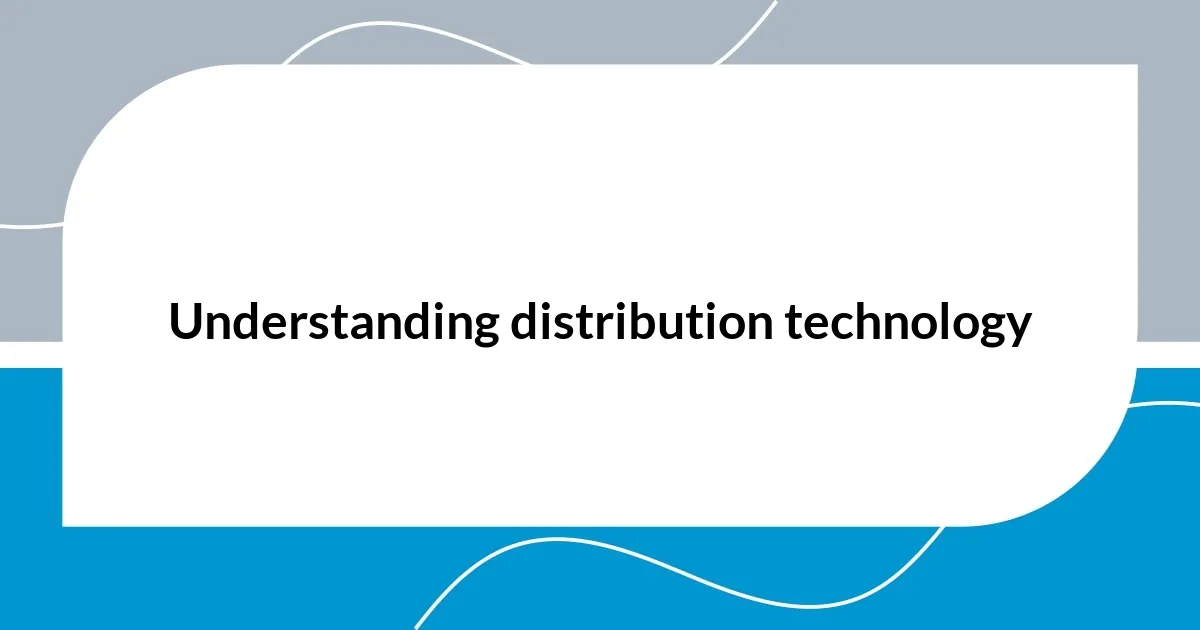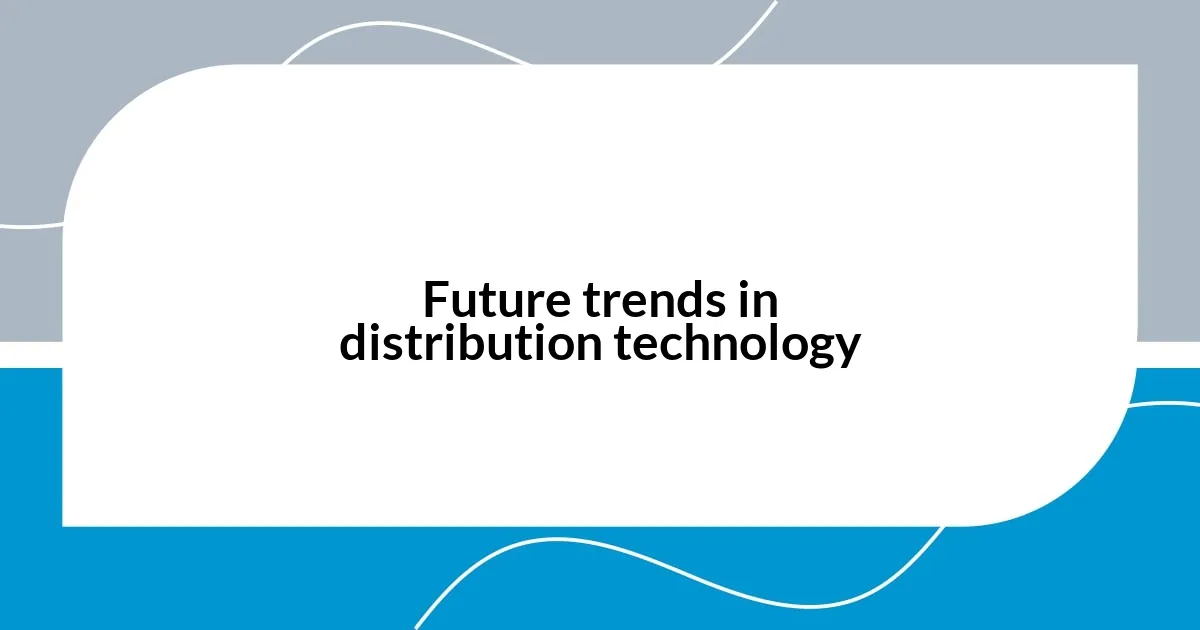Key takeaways:
- Distribution technology, including real-time data analysis and inventory management systems, significantly enhances supply chain efficiency and customer satisfaction.
- Advancements like drone delivery and automated fulfillment centers are transforming logistics, promising faster and more precise delivery methods.
- Challenges in distribution include system integration difficulties, keeping pace with rapid technological changes, and ensuring data security.
- Future trends involve the integration of AI for inventory management, augmented reality for operational efficiency, and a push towards sustainability in delivery methods.

Understanding distribution technology
Distribution technology is truly fascinating, as it plays a crucial role in how products reach consumers. I remember a time when I was tasked with optimizing a supply chain for a small business. The integration of sophisticated distribution software not only streamlined our processes but also enhanced our visibility into inventory levels. Have you ever realized how much technology shapes our shopping experience?
As I dove deeper, I found that real-time data analysis is one of the most powerful components of distribution technology. For instance, I once utilized predictive analytics to anticipate product demand during a holiday season. This experience opened my eyes to how businesses can adapt their strategies based on consumer behavior, ultimately leading to higher customer satisfaction.
Moreover, the evolution toward automated distribution systems has been remarkable. I vividly recall attending a seminar showcasing drone delivery technology. It left me thinking about the future: how will these advancements fully transform our logistics landscape, and what does that mean for local businesses? Each innovation seems to push us closer to a seamless distribution experience, and I’m excited to see where it takes us next.

Importance of distribution networks
Understanding the importance of distribution networks is vital in today’s interconnected economy. From my own experience working with various businesses, I’ve seen how efficiently a well-structured network can significantly reduce delivery times and cut costs. Think about your favorite online store—without a robust distribution network, those quick deliveries wouldn’t be possible.
When I once consulted for a medium-sized retailer, I quickly learned how their distribution network affected customer loyalty. By implementing logistical improvements through technology, they managed to enhance their delivery metrics. This shift not only delighted their customers but also boosted their overall market presence. It’s fascinating how a single adjustment in the distribution strategy can ripple through an entire business.
Furthermore, during a recent project focused on sustainability, I was struck by how distribution networks can support eco-friendly practices. By optimizing routes and reducing transportation waste, companies can minimize their carbon footprint. Have you ever considered how much easier it could be for us to shop sustainably if distribution networks prioritized efficiency? It’s a thrilling thought to explore the potential for future developments in this area.
| Importance of Distribution Networks | Examples |
|---|---|
| Efficiency | Fast delivery times and lower costs |
| Customer Loyalty | Improved delivery metrics enhance consumer satisfaction |
| Sustainability | Optimized routes reduce carbon emissions |

Key components of distribution technology
One fundamental component of distribution technology is the use of advanced inventory management systems. I remember an instance when I worked with a startup that faced challenges in tracking its stock. We adopted a cloud-based inventory system, which granted us real-time visibility and drastically reduced the chances of stockouts. The stress relief this brought to the team was palpable—it’s remarkable how a little technology can transform chaotic operations into a smooth flow.
Another critical element is distribution management software, which facilitates streamlined operations. It was eye-opening to see how this software could integrate diverse logistics processes, from order processing to transportation scheduling. I once witnessed a trucking company reduce its route planning time by half just by implementing an efficient management system. Here’s a brief overview of the key components:
- Real-Time Data Analysis: Provides insights to make immediate decisions.
- Inventory Management Systems: Ensures stock levels are monitored effectively.
- Distribution Management Software: Streamlines logistical operations.
- Automated Solutions: Enhances efficiency through technology like robotics and drones.
- Predictive Analytics: Anticipates demand and optimizes supply chains accordingly.
Each component interacts in ways that enhance the overall distribution process, creating a web of synergy that can propel businesses toward success.

Innovations in distribution methods
The landscape of distribution methods is evolving at a breathtaking pace. I recall a recent event where a presenter discussed drone delivery systems that are not just theoretical anymore but are being rolled out in select urban areas. This innovation has the potential to transform how quickly products reach consumers. Imagine ordering a product and having it delivered within a matter of minutes! How convenient would that be for our busy lives?
In my experience, automated fulfillment centers are another game changer. I had the opportunity to visit one of these facilities, and I was genuinely amazed by the robots swiftly navigating the aisles, picking orders with incredible precision. This technology not only increases efficiency but also reduces human error. It’s a thrilling prospect, don’t you think? As I watched those robots in action, I couldn’t help but wonder: will we see fully automated distribution centers become the standard in the coming years?
Additionally, the rise of blockchain technology in distribution is fascinating. I once collaborated with a tech firm exploring how blockchain could enhance supply chain transparency. The ability to trace a product’s journey from manufacturer to consumer is groundbreaking. It invokes a sense of trust—consumers can see exactly where their items come from. Imagine how empowering it would be for buyers to know the full lifecycle of their purchases. Doesn’t that add a layer of connection in our increasingly digital world?

Challenges in distribution technology
When diving into the challenges of distribution technology, one major hurdle I often think about is the integration of various systems. During a project with a mid-sized retailer, we encountered significant difficulties when merging different software platforms. It felt frustrating as the lack of seamless communication between these systems delayed shipments and muddled inventory data. Have you ever tried to connect dots that just wouldn’t meet? I believe that without proper integration, it can feel like navigating a maze blindfolded.
Another challenge is the rapid pace of technological change. I still vividly remember a conversation I had with a logistics manager who expressed his anxiety about keeping up with new tools and processes. It’s a juggling act, isn’t it? With technology evolving constantly, companies often find themselves investing in solutions that might soon become obsolete. It raises the question: how can businesses ensure they’re making the right investments without falling into the trap of perpetual upgrades?
Lastly, let’s not overlook the importance of data security. In one workshop on distribution technology, a cybersecurity expert highlighted the potential vulnerabilities that accompany increased digitalization. I left that session pondering just how fragile our reliance on technology could be. Knowing that sensitive information is at risk can be unnerving, don’t you think? Addressing these security concerns is crucial; otherwise, the ramifications could ripple through the entire distribution network.

Future trends in distribution technology
As we look ahead, one intriguing trend in distribution technology is the integration of artificial intelligence (AI). I remember attending a tech expo where I saw AI-driven analytics predicting consumer behavior. Imagine a scenario where systems adjust inventory levels based on real-time purchasing trends! I found myself thinking about how this could significantly reduce waste and ensure that popular items are always in stock. Doesn’t that make you feel hopeful about a more efficient future?
Another captivating trend is the increasing use of augmented reality (AR) in warehousing and inventory management. I once participated in a pilot program where employees used AR glasses to locate products quickly. The excitement in the room was infectious as everyone saw how much easier it was to navigate large spaces. The potential for AR to streamline operations and enhance training is immense. Can you picture a day when these tools replace traditional training manuals, revolutionizing how we educate our workforce?
Finally, we shouldn’t underestimate the escalation of sustainable practices within distribution. Recently, I read about a company pioneering electric delivery vehicles that not only cut emissions but also serve as a marketing tool for eco-conscious consumers. It made me reflect on how the demand for sustainability is becoming intertwined with innovation. How powerful would it be if every product we bought came with a story of environmental responsibility? It’s an exciting time to witness this shift in values, isn’t it?